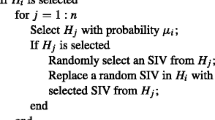Abstract
Many real-world problems are multimodal, which means algorithms should have the ability to find all or most of the multiple solutions as opposed to a single best solution. Niching is the technique that can help evolutionary algorithms to find multiple solutions. Attraction basin sphere estimation (ABSE) is a newly proposed niching method which has the power of inferring the shape of fitness landscapes by spending some extra evaluations. However, when we apply ABSE to genetic algorithms, those extra evaluations lead to an efficiency problem. However, we notice that the combination of ABSE and covariance matrix adaptation evolution strategy will not cause the efficiency problem and have a good performance. This paper implements this idea and performs experiments on a benchmark set provided by CEC 2013 niching methods competition. The algorithm is compared with the best 5 algorithms in the competition. The results show that the proposed algorithm obtains a good result. The features of the proposed algorithm are also discussed in detail.




















Similar content being viewed by others
References
Cioppa AD, Stefano CD, Marcelli A (2007) Where are the niches? Dynamic fitness sharing. IEEE Trans Evol Comput 11(4):453–465
Derrac J, García S, Molina D, Herrera F (2011) A practical tutorial on the use of nonparametric statistical tests as a methodology for comparing evolutionary and swarm intelligence algorithms. Swarm Evol Comput 1(1):3–18
Epitropakis MG, Plagianakos VP, Vrahatis MN (2011) Finding multiple global optima exploiting differential evolution’s niching capability. In: IEEE symposium on differential evolution. IEEE Press, New York, pp 1–8
Epitropakis MG, Li X, Burke EK (2013) A dynamic archive niching differential evolution algorithm for multimodal optimization. In: Proceedings of congress of evolutionary computation. IEEE Press, New York, pp 79–86
Hansen N, Ostermeier A (2001) Completely derandomized self-adaptation in evolution strategies. Evol Comput 9(2):159–195
Li JP, Balazs ME, Parks GT, Clarkson PJ (2002) A species conserving genetic algorithm for multimodal function optimization. Evol Comput 10(3):207–234
Li X, Engelbrecht A, Epitropakis MG (2013) Benchmark functions for CEC’ 2013 special session and competition on niching methods for multimodal function optimization. Tech. rep., Evolutionary Computation and Machine Learning Group, RMIT University, Australia
Miller BL, Shaw MJ (1996) Genetic algorithms with dynamic niche sharing for multimodal function optimization. In: Proceedings of congress of evolutionary computation. IEEE Press, New York, pp 786–791
Molina D, Puris A, Bello R, Herrera F (2013) Variable mesh optimization for the 2013 CEC special session niching methods for multimodal optimization. In: Proceedings of congress of evolutionary computation. IEEE Press, New York, pp 87–94
Preuss M (2012) Improved topological niching for real-valued global optimization. In: EvoApplications. Springer, Berlin, pp 386–395
Preuss M, Schönemann L, Emmerich M (2005) Counteracting genetic drift and disruptive recombination in (\(\mu ^+,\lambda \))-EA on multimodal fitness landscapes. In: Proceedings of genetic and evolutionary computation conference. ACM Press, New York, pp 865–872
Puris A, Bello R, Molina D, Herrera F (2012) Variable mesh optimization for continuous optimization problems. Soft Comput 16(3):511–525
Sareni B, Krähenbühl L (1998) Fitness sharing and niching methods revisited. IEEE Trans Evol Comput 2(3):97–106
Shir OM, Bäck T (2005) Dynamic niching in evolution strategies with covariance matrix adaptation. In: Proceedings of congress of evolutionary computation. IEEE Press, New York, pp 2584–2591
Shir OM, Emmerich M, Bäck T (2010) Adaptive niche radii and niche shapes approaches for niching with the CMA-ES. Evol Comput 18(1):97–126
Stoean C, Preuss M, Stoean R, Dumitrescu D (2010) Multimodal optimization by means of a topological species conservation algorithm. IEEE Trans Evol Comput 14(6):842–864
Stoean CL, Preuss M, Stoean R, Dumitrescu D (2007) Disburdening the species conservation evolutionary algorithm of arguing with radii. In: Genetic and evolutionary computation conference. ACM Press, New York, pp 1420–1427
Ursem RK (1999) Multinational evolutionary algorithms. In: Congress of evolutionary computation. IEEE Press, New York, pp 1633–1640
Ursem RK (2000) Multinational GAs: multimodal optimization techniques in dynamic environments. In: Genetic and evolutionary computation conference, pp 19–26
Xu Z, Polojärvi M, Yamamoto M, Furukawa M (2013a) Attraction basin estimating GA: an adaptive and efcient technique for multimodal optimization. In: Proceedings of congress of evolutionary computation. IEEE Press, New York, pp 333–340
Xu Z, Polojärvi M, Yamamoto M, Furukawa M (2013b) An attraction basin estimating genetic algorithm for multimodal optimization. In: Proceedings of genetic and evolutionary computation conference. ACM Press, New York, pp 131–132
Xu Z, Iizuka H, Yamamot M (2014) Attraction basin sphere estimating genetic algorithm for neuroevolution problems. Artif Life Robot 19(4):317–327
Author information
Authors and Affiliations
Corresponding author
Ethics declarations
Conflict of interest
We declare that we have no financial and personal relationships with other people or organizations that can inappropriately influence our work, there is no professional or other personal interest of any nature or kind in any product, service and/or company that could be construed as influencing the position presented in, or the review of, the manuscript entitled.
Additional information
Communicated by V. Loia.
Rights and permissions
About this article
Cite this article
Xu, Z., Iizuka, H. & Yamamoto, M. Attraction basin sphere estimation approach for niching CMA-ES. Soft Comput 21, 1327–1345 (2017). https://doi.org/10.1007/s00500-015-1865-4
Published:
Issue Date:
DOI: https://doi.org/10.1007/s00500-015-1865-4




